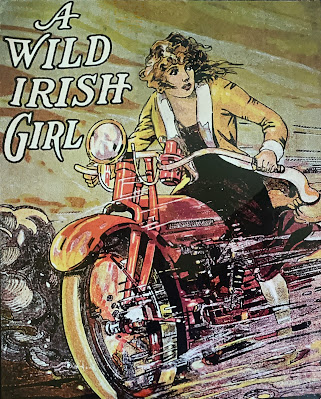 |
| I purchased this poster at the National Motorcycle Museum. |
Tucked away in the small town of Anamosa, Iowa, the National Motorcycle Museum was, until this month, an astonishingly vast and important collection of rare and splendid motorcycles, bicycles, memorabilia and art.
The brainchild of collector and businessman John Parham, the museum was a jewel hidden in the cornfields. Its location was simultaneously intriguing and daunting. Away from the population centers it could never attract the kind of visitation a non-profit museum requires.
Blogger Jorge Pullin visited, commenting that it was a three-plane nightmare that cost as much as a trip to Europe.
The museum closed Sept. 4, 2023 and its remaining 300 motorcycles and 6,000 related but incredibly varied items were auctioned off Sept. 6-9.
I only visited the museum once, wondering simultaneously what it and I were doing in a place as isolated as Anamosa, Iowa.
I was there with my wife, her brother and their mother on a mission to track down their family history. A stop at the motorcycle museum was a treat for me.
It was just too much to take in (watch the video to see what I mean).
But I did take away memories, a museum T-shirt, and a copy of a poster I spotted on the wall entitled "A Wild Irish Girl."
The brave girl depicted in the poster reminded me of the brave woman I married.
It's also a stirring image of a motorcycle at speed, evocative of early 20th Century models.
It's shown with an acetylene headlight, common on the very earliest motorcycles, but the gas tank is more rounded than on the early "flat tank" motorcycles.
Online references occasionally suggest that it illustrated the book "A Wild Irish Girl" by Elizabeth Thomasina Meade Smith, who wrote under the name L.T. Meade. (Note that the source refers to the book as "The Wild Irish Girl," but images of the book show that the title was "A Wild Irish Girl," as in my poster.)
However, that is a 1910 book, and photos of the book itself show a cover with a much more restrained portrait of a girl.
There is more than one version of the book cover online; could the girl on the motorcycle be from a later edition unknown to Google Image Search?
I don't think so. Meade's book can be read online, and, while it is an amusing story of an attractive, independent, and stubborn 15-year-old girl, it does not contain the word "motorcycle." Or even "cycle." Or "moto."
Traffic is often referred to as including "motors," but this is obviously meant to mean automobiles. Patricia, the girl in question, and one of strong opinions, professes to "hate motors."
So, that's not it.
My copy of the poster shows no indication of an author's name (again suggesting it is not a book or magazine cover), or any artist's signature.
L.T. Meade's book was written for young people. A more adult book, "The Wild Irish Girl," by Sydney Owenson, appeared in 1806. Politically controversial for promoting both Irish and female independence, it contained (of course, in 1806) no motorcycles.
So where did the image of the girl on the motorcycle originate? The only clue is the words "A Wild Irish Girl."
The phrase "wild Irish girl" has been around probably as long as Irish girls.
Mid-16th Century England denied citizenship to the people of the "wild Irish nation."
"The term would be appropriated by the Irish themselves in latter years, depriving it of its sting," one source notes.
There's no doubt the daring Irish girl on the motorcycle is depicted as an example of bravery. She appears to me to be fleeing, either in desperation or determination. Her goal is more important to her than the impending crash.
She's riding that motorcycle "like she stole it."
The museum's framed copy of the poster I have was to be auctioned off in company other posters of women motorcyclists, as Lot 366.
Mine is not for sale.


























No comments:
Post a Comment